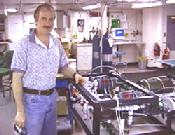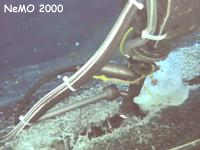| |
Participant
Interview:
Dave Butterfield
Chemist
University of Washington/Vents Program
Jeff: What research are
you working on at Axial Volcano?
Dave: I'm working on the chemical composition of hydrothermal fluids coming
out of Axial Volcano. The emphasis lately is to concentrate on diffuse
low temperature vents, mainly because that's where the microbiology is
happening. They really can't survive in the hottest vents. We collect
coordinated samples and compare the chemistry and the microbiology. Eventually,
we'll have a microbial "map" that goes along with the chemistry "map"
of the area. Everything flowing from the diffuse vents is coming out of
the seafloor, so when your sampling vents your sampling what's happening
below the seafloor.
Jeff: What's your main
tool for sampling hydrothermal vent fluids?
Dave: The vent fluid sampler is the tool for collecting fluids and particles
and does a range of fluid measurements. It was created due to the frustration
of trying to get vent fluid samples out of ROPOS. The only way to do that
was take one of their titanium samplers down, holding onto it in one of
the arms for the entire dive and triggering it. One shot. If it didn't
work you spent that dive and didn't get a sample. So, we decided if were
going to work with ROV's we really have to make a tool that will be efficient
for collecting water. The first vent fluid sampler was completely different
from this one. It was a really nice looking system all made out of titanium.
We took it out in October of 1996 on an emergency response cruise north
of here. There was an ocean drilling project that had drilled into a hydrothermal
system and created a black smoker vent. It was a huge drill hole down
into a hot reservoir and fluid started pouring out the hole. We got some
dive time but there was a huge storm. The sampler was on an ROV and we
lost both the ROV and our sampler. So, that was the end of our beautiful
titanium sampler. After that, we made a lighter sampler to fit various
ROV's. The new one is made to go on ROPOS easily and JASON as well. It
takes enough samples that you can be down for a while and get a lot of
samples from different areas.
Jeff: What do you find
most interesting about hydrothermal vent systems?
Dave: I enjoy looking at it as a big puzzle and trying to understand how
these volcanic systems work. In general, I like using chemistry to understand
what's happening below the sea floor. But, you can't just look at the
chemistry. In order to make it all fit together, you need to be out here
with the geologists and the microbiologists. This multi-disciplinary approach
is a neat process.
|
|

Dave Butterfield preparing
the fluid sampler for deployment on ROPOS.

ROPOS using the fluid sampler
at Marker 33.
|
|

